


Dinosaurs were one of many kinds of reptiles that lived during the Mesozoic Era - a period of time often called the Age of Reptiles. For as long as 160 million years in some regions, dinosaurs dominated the land. They adapted to every kind of habitat and were incredibly successful. Some dinosaurs were the size of small birds and others were longer than three houses stacked on top of one another!
One of the reasons for their success was their straight, upright back legs. This saved them lots of energy, supported their weight better and enabled them to move more quickly over different terrain.
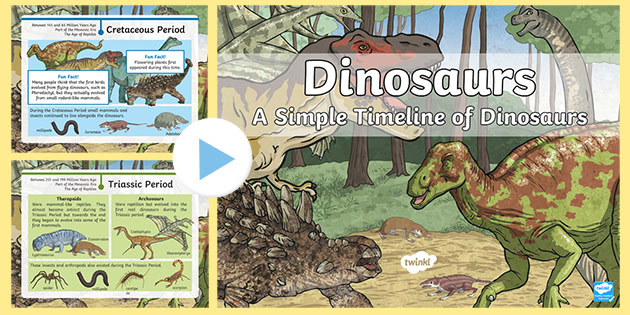 Click the image above to learn about where and when different dinosaurs lived with a handy illustrated PowerPoint.
Click the image above to learn about where and when different dinosaurs lived with a handy illustrated PowerPoint.
Look out of your window, or listen when you’re beside a hedge or by a tree. You may hear and see dinosaurs.
Yes, birds today are the living descendents of a group of dinosaurs! Just like birds, there is increasing thought that some species of dinosaurs had feathers, too.
During the Age of Reptiles, most animals alive on earth belonged to a huge group called the Archosaurs. Archosaur means ‘ruling reptile’ - for obvious reasons. They have shared features like a special hole in their skull. Palaeontologists use these features to identify different animals from fossils.
Dinosaurs were just one group of archosaurs. Alive at the same time was a group of archosaurs called pterosaurs. The ancestors of alligators and crocodiles were also alive during the same time, too. Like birds, the crocodilians have survived to the present day.
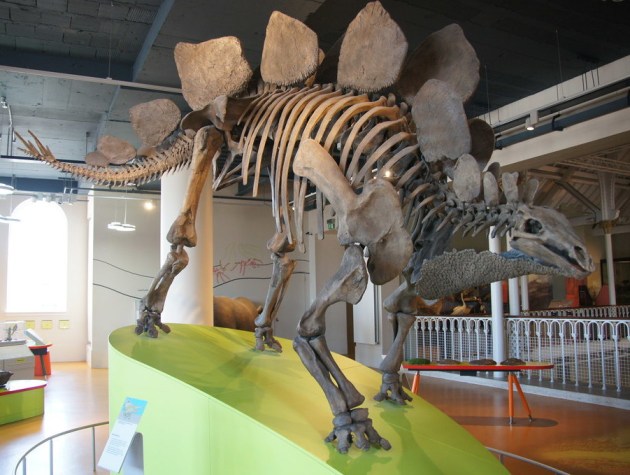
The Mesozoic era lasted 180 million years. It began roughly 250 million years ago and ended 65 million years ago (the time of the mass extinction event which ended the Age of the Reptiles). During this era were three periods you’re probably familiar with:
Each period spanned millions of years and was characterised by unique climatic conditions and kinds of life living on the planet.
Click the image above to learn about the extinction of the dinosaurs with this fact-filled, interactive PowerPoint.
It’s worth remembering that at the beginning of the Triassic period, living organisms roamed the great supercontinent Pangaea. This provided lots of space for large animals (like dinosaurs) to move and migrate across land - almost completely from the North to the South Pole! During the Mesozoic era, this land mass eventually split into (almost) the continents we recognise today. As the plates of the earth moved, so did the land sat on top of those plates. This led to populations being split apart by seas and mountains. Animals and plants adapted to their habitats over time, and life on earth became more diverse (different).
Do you want to know more about this fascinating dinosaur, read through our list of Stegosaurus facts!
A Stegosaurus’ brain was the size of a walnut
First up on this list of Stegosaurus facts, let’s talk about the huge dinosaur’s tiny brain.
You would think that, given the huge scale of the Stegosaurus, the dinosaur would have a pretty big brain to match, but you would be mistaken. This dinosaur’s brain was actually proportionately tiny to the rest of its body. It is believed that the brain of a Stegosaurus would have been around the same size as a walnut, which is similar to what golden retrievers have. The teeny tiny size of the Stegosaurus’ brain didn’t affect its life too much, thankfully, as it didn’t have a very intellectually-demanding lifestyle. All the Stegosaurus needed to survive was to be smarter than its prey, which in the case of this dinosaur was primitive ferns and cycads. It also needed to be smart enough to avoid predators, and considering how ferocious the Stegosaurus was, there were not many of these.
The Stegosaurus’ spikey tail is called a 'Thagomizer'
One of the key physical features of the Stegosaurus is its huge, spiked tail. This tail is now widely known as the ‘thagomizer’, which is a fittingly terrifying name for what it’s describing. This name only came about in 1982, however, in quite an odd turn of events. The name was first coined in a famous comic strip at the time called, “Far Side”. The cartoon portrayed a group of cavemen gathered around an image of a Stegosaurus tail, with one of them pointing at the sharp tail and remarking: “"Now this end is called the thagomizer ... after the late Thag Simmons." Gary Larson, the creator of “Far Side” was the brain behind this cartoon. The name took off, and it has been used by palaeontologists to refer to the Stegosaurus’ tail ever since.
Stegosaurus' plates are a bit of a mystery
This Stegosaurus fact is shrouded in mystery. The meaning of the name, ‘Stegosaurus’, is ‘roofed lizard’, which dates back to the 19th century belief that the dinosaur's plates lay flat along its back. This was a widely held belief among palaeontologists at the time, but it has since been brought under a lot of questioning. A number of reconstructions of the Stegosaurus have been made to try to deduce the true arrangement of the dinosaur’s plates. The most likely conclusion is that the plates were arranged in alternating parallel rows, with the pointy ends facing up. This arrangement would have stretched all the way from the Stegosaurus’ neck down to its bottom.
The Stegosaurus used to eat small rocks
Whilst it was not a main component of its diet, the Stegosaurus did swallow a fair amount of small rocks as part of its diet. This was the case for a lot of the plant-eating dinosaurs in the Mesozoic Era. It was intentional for these creatures to swallow small rocks that were called gastroliths, but they didn’t do it for the taste. These gastroliths actually helped crush up the tough vegetable matter that creatures like the Stegosaurus were eating, which was really helpful for their digestion. As it was so huge, the Stegosaurus would have had to eat hundreds of pounds of ferns and cycads every day to maintain its metabolism, which would’ve been really hard to digest.
The Stegosaurus was one of the first dinosaurs to have cheeks
This Stegosaurus fact may shock you, as we don’t often think of the Stegosaurus as having big rosy cheeks. Whilst they might not have looked exactly like human cheeks, the Stegosaurus was actually one of the earliest dinosaurs to develop this body part. As mentioned before, the Stegosaurus’ diet was pretty tough to digest, and so Scientists believe that having cheeks allowed them to chew their food thoroughly and predigest it before swallowing.
People used to think that the Stegosaurus walked on two legs
The Stegosaurus was discovered fairly early on in palaeontological history, and so the knowledge around it was limited. As such, some very strange theories around the Stegosaurus existed. One of these theories was that the Stegosaurus was bipedal, meaning that it walked on two legs. Whilst this theory has now been debunked, there are still some experts that believe the Stegosaurus was capable of rearing up on its hind legs when threatened.
The Stegosaurus was one of the inspirations behind Godzilla
The Stegosaurus, along with the Tyrannosaurus Rex and Iguanodon, served as inspiration for the creation of the fictional monster, Godzilla.
The Stegosaurus was one of many Stegosaurids
Stegosaurus was one of many Stegosaurids - a family of quadrupedal (4-legged) bony-plated herbivores (plant-eating). Stegosaurid means ‘roofed lizard’ due to the big, bony plates along their spines. 
The biggest Stegosaurid was 9 metres long
The largest Stegosaurid was a stegosaurus, which was around 9 meters long! For comparison, even at such a size, they would have looked tiny compared to some other dinosaurs roaming the lands. Diplodocus, a fellow herbivore in the Late Jurassic period, was 26 meters long!
The plates on the Stegosaurus' back are called 'scutes'
The 17 bony plates along their backs are called scutes and are made out of a bony material but were not hard - they had their own blood supply throughout them. It’s believed they might have helped them to regulate their body temperature and maybe even display.
The exciting thing about studying dinosaurs is thinking through how animals today use similar body parts or behaviours and making theories about what dinosaurs might have been like - given other things we know for sure from evidence. That’s partly why learning about dinosaurs is an engaging and relevant way for children to practise analytical skills and reasoning. For more support, take a look at this Science Subject Overview to help organise your planning for teaching children aged 5 - 7.
The Stegosaurus had incredibly dangerous spikes
Stegosaurus had spikes which pointed outwards from the sides all along the end of their highly flexible tails. Fossils of stegosaurus’ main predator, allosaurus, have been found with puncture wounds from these spikes - and the spikes have likewise been found broken at the tips. All indications lead scientists to believe they were used in the defence strategy of these plant-eating gentle giants.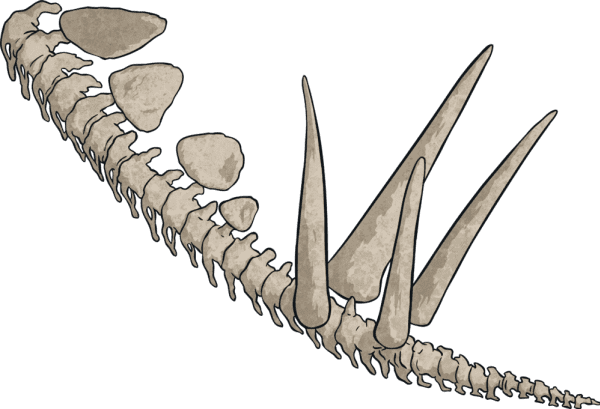
Stegosaurus' front legs were shorter than their back legs
Their front legs were shorter than their hind legs, which led to stegosaurus likely having to move very slowly. This imbalance also led to a head-down posture; over time, this led to stegosaurus developing a narrower and pointier skull than other similar herbivores. 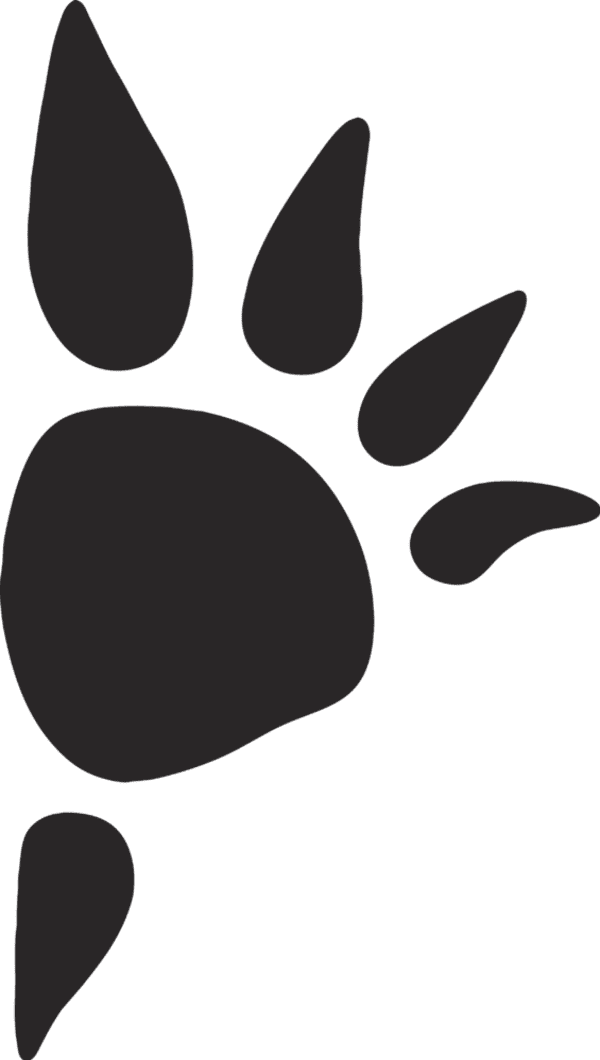
Scientists rely upon palaeontologists and geologists to find fossils in order to better understand dinosaurs of the past, like stegosaurus.
The Morrison Formation is a sequence of rock in the western United States.The sedimentary rock layer is dated to the Upper Jurassic period. You can see these sequences quite clearly - there are distinctive banded layers on the surface of hills in an area now called the Dinosaur National Monument (featuring the Dinosaur Quarry) - named for the amazing finds which have been discovered in these layers of rocks.
The formation itself is named after Morrison, Colorado, where the first fossils were found in 1877. In fact, Stegosaurus is the state dinosaur of Colorado!
Hundreds of fossils of dinosaurs and fragments of other animals and plants have been discovered in the decades since - and 75% are still buried to the east.
Around 80 stegosaurus fossils have been discovered in the Morrison Formation. Findings like these help us to map where stegosaurus would have lived.
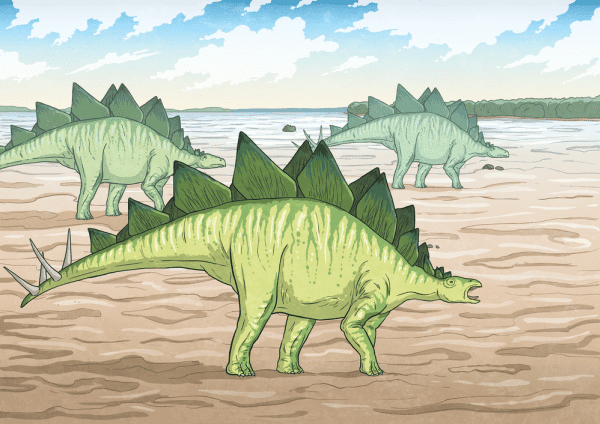
Fossils are the preserved remains of parts of whole living organisms from millions of years ago. In collections today, you’ll find fossilised remains of animals, plants, fungi, and even animal poo.
Fossils are formed when animals like birds, dinosaurs, and mammals die and their remains become covered with layers of earth or sand. Over time, these layers build up and become compressed and hardened into rock. An impression of the animal is left. This is a process which takes place over millions of years.
Fossilisation is actually quite rare: a specific set of conditions are needed for fossilisation to occur. It's most likely to happen underwater, where animal remains are quickly covered by sediments like sand or mud. That's why 99% of fossils found are from marine life!
Findings in western North America have helped us to understand not only where stegosaurus lived, but how they lived, too. Stegosaurus fossils have also been found in Portugal!
During the Late Jurassic period, there was likely a land bridge between modern North America and Europe which surfaced at low tide, allowing these animals to migrate between the two continents when they were closer together.
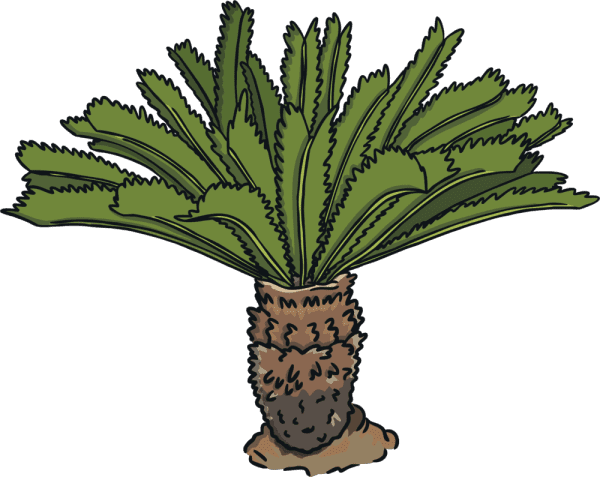
Lots of other stegosaurids - from the Chunkingosaurus to the Chialingosaurus - have been discovered across Asia, where there were likely huge populations.